A few months ago, my 6-year-old German Shepherd started limping on her back leg. It’s not a pleasant sight to see any dog limping, and if your GSD starts limping on either his front legs or back legs, it’s only natural to wonder if it is a minor issue or something more significant.
However, before you rush your dog to the vet, you might want to learn more about why he may be limping in the first place.
German Shepherds may limp for various reasons. Minor causes could be simple over-exertion, an insect sting, an ingrowing toenail, or a thorn stuck in the paw. Injury or disease, such as fractures, sprain, hip dysplasia, spinal cord disease, or bone cancer, can be more serious causes.
These are just a few of the reasons your GSD might be limping, but we’ll cover a great deal more in this article. This will help you figure out what might be wrong with your dog.
I’ll also tell you how to treat your limping German Shepherd at home and when to take him to the veterinarian.
Let’s get started!
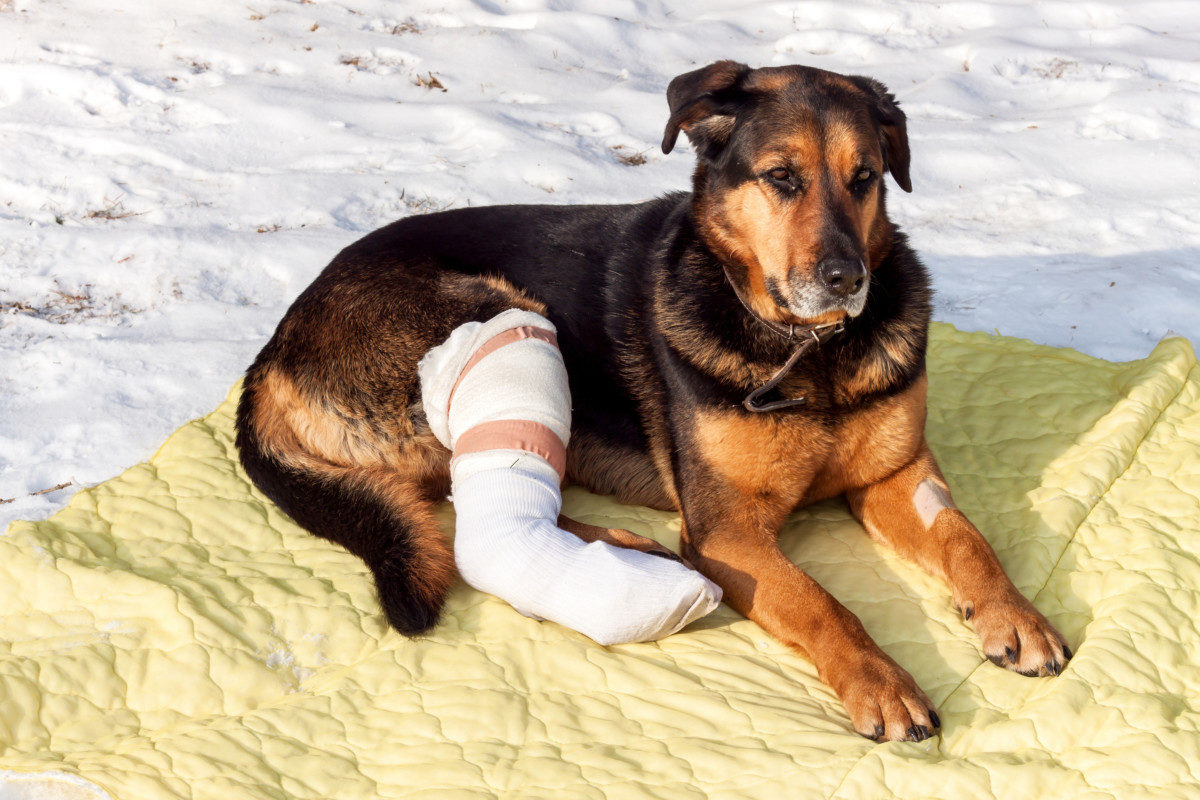
Causes of Limping in German Shepherds
Limping is a common occurrence in dogs. It occurs when your dog cannot walk normally due to pain or weakness. Your dog may walk slowly or awkwardly, and he will generally favor one leg over the other. This means that one leg is at risk and needs your attention.
There are two types of limping that your German Shepherd may experience. Some forms occur gradually over time, whereas sudden lameness happens instantly, usually after an injury.
Some cases are minor and can be managed at home, while others will necessitate the assistance of a medical professional. The risk level totally differs based on age, health condition, food, and other associated factors.
Reasons Why Your Dog May Be Limping…
Here are 23 reasons why your German Shepherd may be limping:
1. Overexertion
Too much of a good thing, such as fetch, frisbee, intense running, or rough play with other dogs, can leave your German Shepherd sore and hobbling with a muscle strain. Most dogs, though, will recover quickly after a few days of rest.
2. Wounds on the footpads
Check your dog’s paws for foreign objects that could cause lacerations, such as a piece of glass or a nail. Look out for your canine incessantly licking his paw. Burns caused by hot sidewalks or frostbite can also cause your dog to limp. In extreme weather, hot or cold, get your GSD some booties or paw protectors.
3. A thorn or stone stuck in the pads
Again carefully check the pads for a thorn or small stone that may have lodged between the paw pads. Remember to keep the fur around the pads and toes trimmed to enable you to examine the paws more easily, especially as some dogs find this area quite sensitive.
4. Toenail injuries
Examine your German Shepherd for ingrowing or overgrown toenails, as these can cause discomfort and pain if they dig into the skin. My GSD once had a dewclaw injury that required surgical removal, so make sure you also keep these trim.

5. An insect sting or animal bite
Stings and bites can cause limping. Your GSD may raise his paw if stung by a wasp or bee. Bites from other animals can result in injury and infection. Check if your GSD is at risk of any other disease.
6. Fracture or dislocation
If the limping began suddenly, a fractured leg or a dislocated bone should be suspected. Remember that broken bones aren’t always visible. A shattered bone will prevent your dog from bearing any weight.
7. Sprain
A sprain occurs when a ligament or tendon is strained or torn. Something as simple as leaping off the couch and landing awkwardly can cause it. Your German Shepherd will be reluctant to put any weight on his leg or paw.
8. Hip and elbow dysplasia
Dysplasia is a common hereditary condition in GSDs that causes hip and elbow joints to become loose and shift out of position. Sadly, 20.5% of GSD will suffer from bad hips, and 18.8% will have elbow dysplasia.
9. Osteoarthritis
This persistent, painful condition is more common in older and larger canines. As a result of cartilage deterioration, it causes joint inflammation. Lameness, stiffness, or trouble getting up are all symptoms. If your GSD regularly climbs a staircase, remember that stairs aren’t recommended for them.
10. Cruciate ligament injury or disease
This occurs when one or both of the cruciate ligaments that hold the knee together are damaged. Limping is the most common symptom of a cruciate injury, and it can be caused by turning awkwardly, jumping, or twisting. It can happen all of a sudden or gradually.
11. Luxating patella (dislocated knee)
This is when your dog’s kneecap moves out of its natural position. It is common in smaller breeds, but German Shepherds are one of the larger breeds prone to developing luxating patellas. Your dog may be in pain and reluctant to bear weight on the affected limb.
12. Infection
An infection of the leg or paw can cause your dog to hobble. He may lick and chew the site and may need a course of antibiotics. Also, to prevent further inflammation, your GSD may be advised to wear the dreaded cone of shame (Elizabethan collar).
13. Lyme disease
This bacterial infection spread by ticks can result in intermittent lameness. Remember to keep on top of your GSD’s flea and tick prevention.
14. Degenerative Myelopathy
This genetic condition affects the spinal cord, leading to eventual paralysis of the back end in older dogs. Weakness, lameness in the rear legs, and incontinence are all symptoms.
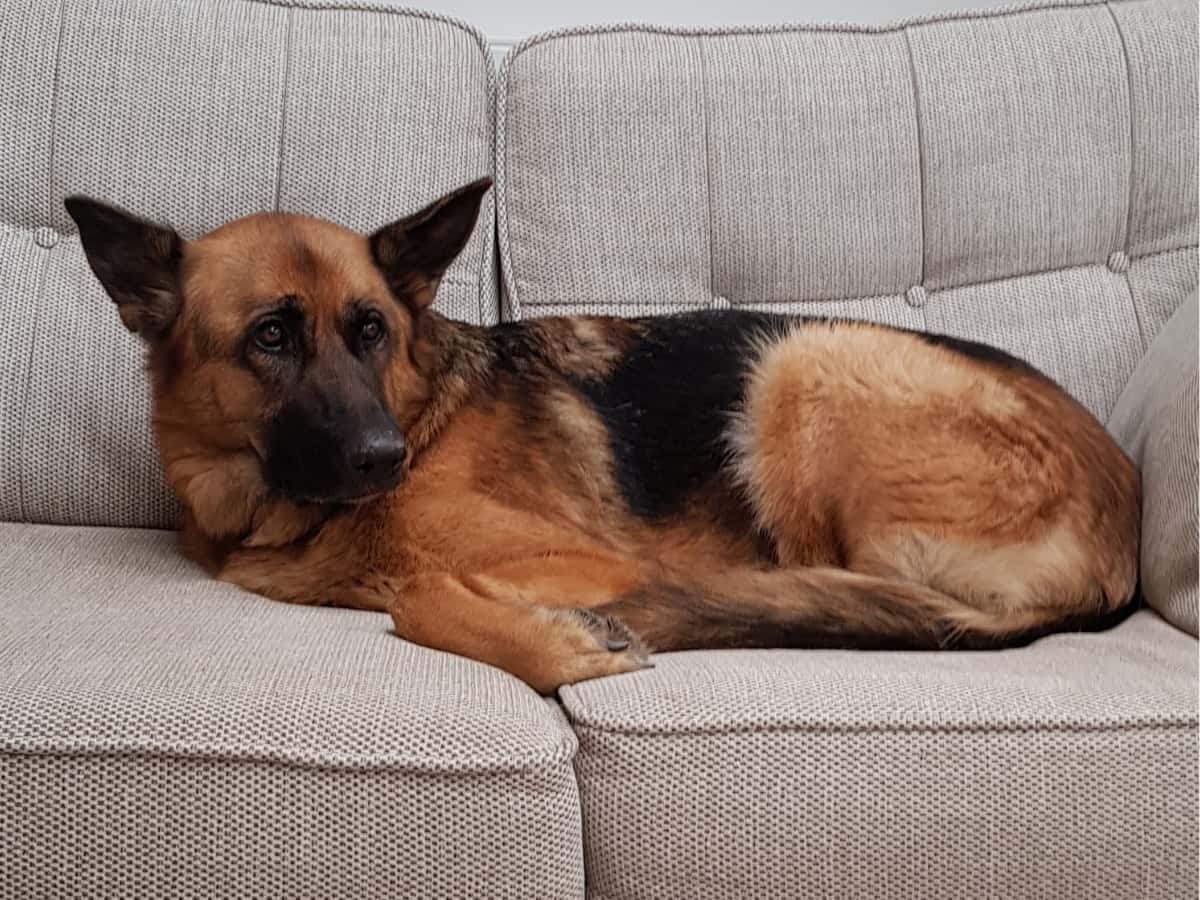
15. Panosteitis (Wandering Lameness or Growing Pains)
Panosteitis is a condition affecting the long bones of the legs due to severe inflammation. It can affect growing large breed pups aged 5-12 months, including the GSD. It causes a shifting lameness from one bone to another and can occur over several weeks or months.
16. Hypertrophic Osteodystrophy (HOD)
Hypertrophic Osteodystrophy is a bone disease occurring in quick-growing large dogs, usually between the 3 and 5-month stage. The German Shepherd is one of the breeds prone. Signs will be a slight limp and pain in the affected bone.
17. Osteochondritis Dissecans (OCD)
OCD is a disease that happens when cartilage grows too fast and doesn’t attach well to the bone underneath. This leads to weakened areas that can break off due to regular movement. The shoulder is the most usually affected area; however, the elbow, hip, and knee can also be impacted.
It occurs when large puppies develop too quickly. Symptoms include limping, lameness, and pain. German Shepherds are predisposed to OCD; however, the offending gene has not been identified.
18. Intervertebral Disk Disease (IVDD)
Hind limb weakness, paralysis, or urinary incontinence are symptoms of this spinal disease. It is caused by intervertebral disk degeneration and protrusion, which compresses the spinal cord.
Dog breeds having a short, stout appearance are most commonly affected. However, the GSD is among the larger dog breeds associated with IVDD.
19. Lumbosacral Foraminal Stenosis
A degenerative condition of the lower spine resembling sciatica or a slipped disc in humans. The subsequent narrowing can cause nerve compression resulting in lameness.
It occurs in medium-large breeds of middle to old age. Unfortunately, German Shepherds and working dogs are susceptible to Lumbosacral Stenosis.
20. Immune-Mediated Polyarthritis
This is an immune system condition that results in inflamed, swollen, and painful joints. Your German Shepherd is at risk and will be reluctant to walk or will limp on one or more legs due to the pain.
21. Diabetic neuropathy
If diabetes is uncontrolled, excessive blood glucose can cause gradual weakness or paralysis due to nerve damage. However, this condition is rare in canines.
22. Congenital limb deformities
Abnormally developed limbs can cause your dog to limp. These are pretty rare, and a study of congenital deformities of the limbs highlighted that little is known about the causes.
23. Osteosarcoma (bone cancer)
Bone tumors can grow quickly, causing limping and pain, especially in the legs. Large and giant breeds are more prone to it. Limping can range from mild to severe.
How I Help My German Shepherd, Willow
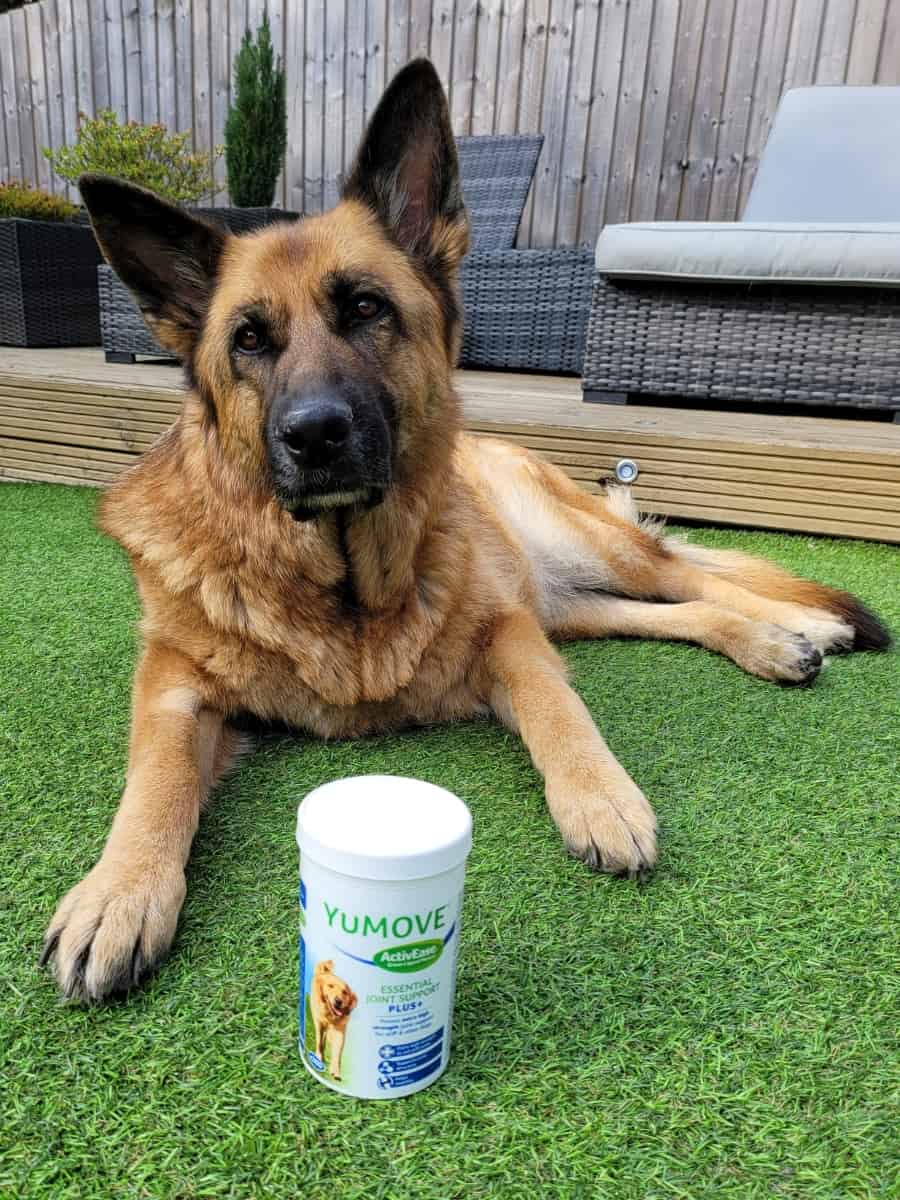
So, if you’re wondering the cause of my German Shepherd’s limping, unfortunately, following a CT scan, she was diagnosed with Spinal Osteoarthritis (no. 9) and Lumbosacral Foraminal Stenosis (no. 19).
However, she is doing really well with exercise modification techniques along with anti-inflammatory and pain relief medication.
I also give her YuMOVE hip and joint supplements from Amazon. My vet recommended these; they get good reviews online, and they seem to be working for her.
Note: Clicking the above link(s) will take you to Amazon or an online store where we have an affiliate relationship. If you make a purchase, we may earn a commission at no additional cost to you.
X-rays can help in understanding the magnitude of the issue better. Don’t hesitate to take one!
Below, you can see Willow’s CT images showing the affected areas:
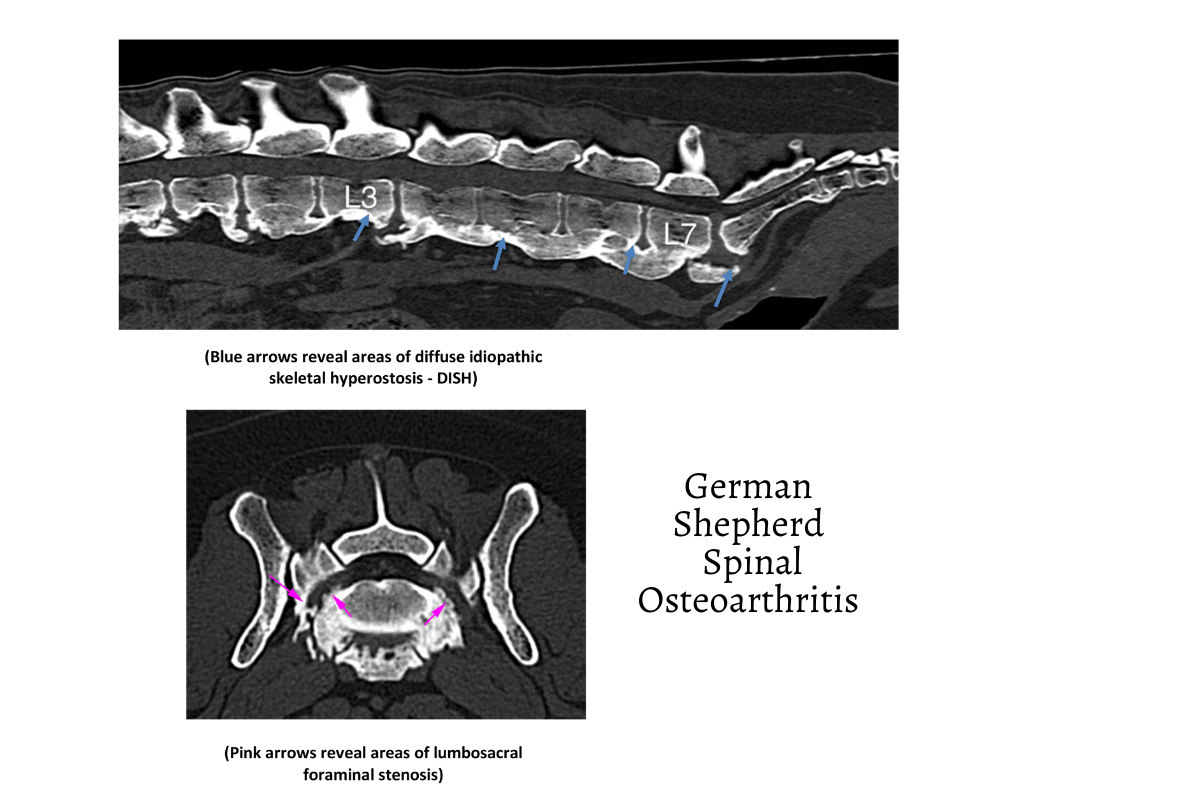
Willow also has a good orthopedic dog bed. She sleeps on the Big Barker, which is the only dog bed clinically proven to reduce pain and joint stiffness. I’ll admit, it’s pricey, but it comes with a 10-year guarantee, so it virtually lasts your dog’s lifetime.
In any case, I’m more than happy to pay for something that eases my dog’s discomfort.
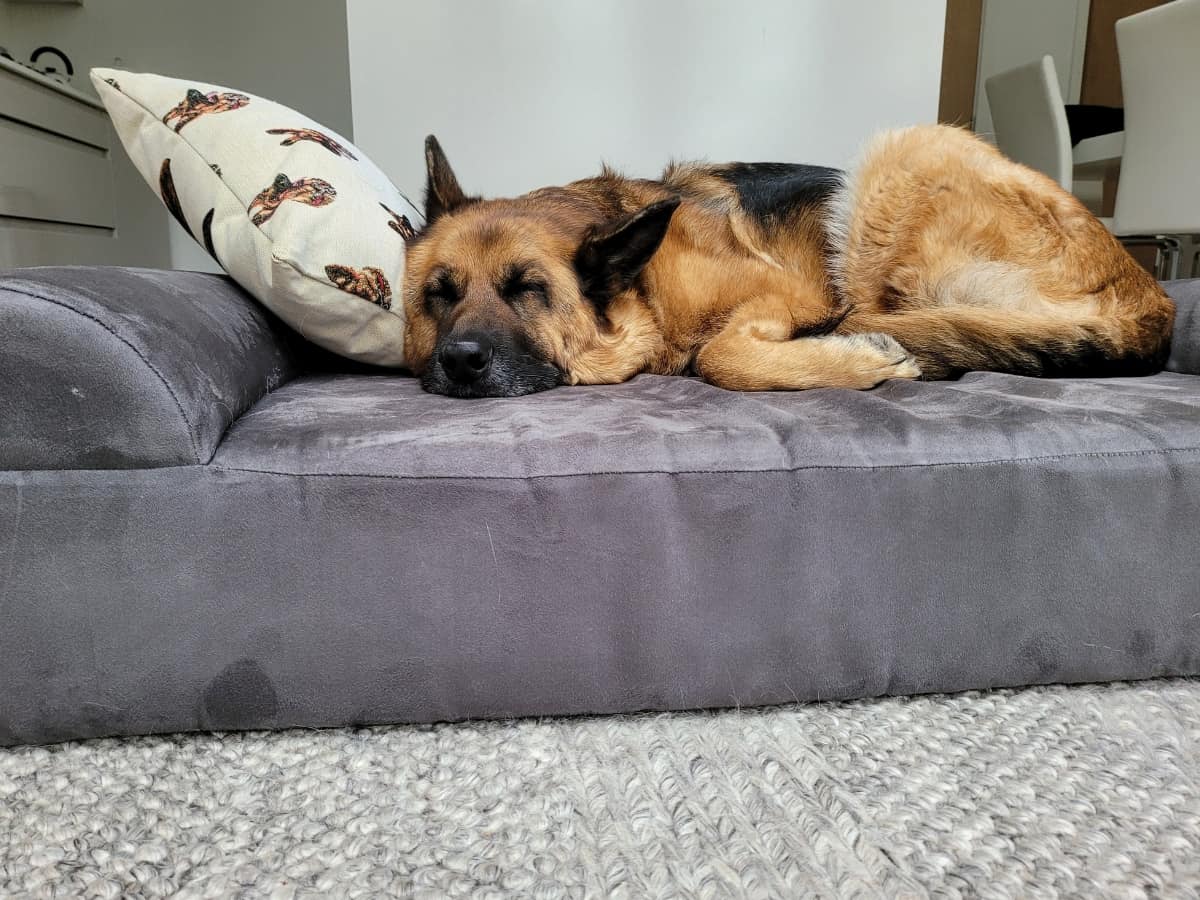
When To Seek Care
If your German Shepherd is limping, you can manage some minor causes at home, such as a sprain, by restricting your dog’s exercise or allowing complete rest for a few days and/or anti-inflammatories and painkillers. For more severe cases, such as broken bones, orthopedic surgery may be required.
Let’s investigate this further.
Home Treatment
Knowing how to treat your limping German Shepherd at home by giving first aid is fundamental to help minimize any further injury or pain. Firstly, pinpoint the affected leg, evaluate its seriousness, and whether your dog needs medical assistance. So, how do you treat a limping GSD at home?
To treat a limping German Shepherd at home, gently examine your dog, starting at the paw. Check the pads and between the toes, and slowly work your way up, looking for cuts or foreign bodies. Gently maneuver the joints for stiffness, but do not examine if your GSD is in severe pain.
Watch How to Conduct a Mini-examination on Your Dog…
Here are some easy first-aid tips for non-emergency cases, courtesy of VCA Hospitals.
- Remove any foreign bodies between the toes. Clean the wound with anti-bacterial soap. Soak your German Shepherd’s paw in warm water with Epsom salts to relieve swelling. Finally, apply antibiotic ointment.
- For cut or torn pads and broken nails. Control the bleeding by applying pressure to the wound with a clean towel and raising your dog’s leg. If you cannot stop the bleeding in 10-15 minutes, take your pet to the vet. Apply a bandage and change daily.
- For burned paw pads. Soak your German Shepherd’s foot in room-temperature water. If the pad becomes discolored or if the tissue underneath becomes exposed, contact your veterinarian. Apply antibiotic ointment to the burned pad and bandage, and change the dressing daily.
- For abscesses. Apply warm compresses to the affected area or soak in a warm Epsom salt bath. If the abscess bursts, take your doggo to the vet to get the wound cleaned and some antibiotics.
- For swelling due to a sprain or bruising. Apply ice packs to the affected area for 15 minutes twice a day. Place your GSD in the bath, swirl the water around his leg, or spray with a gentle hose for 15 minutes twice daily. Flowing water reduces swelling, improves circulation, and helps with healing.
- Confine lame dogs and restrict their activity.
Your German Shepherd will have a far better chance of recovery if you provide first aid when appropriate and seek prompt veterinary care if needed. When the vet suggests x-rays, prioritize and cooperate with him.
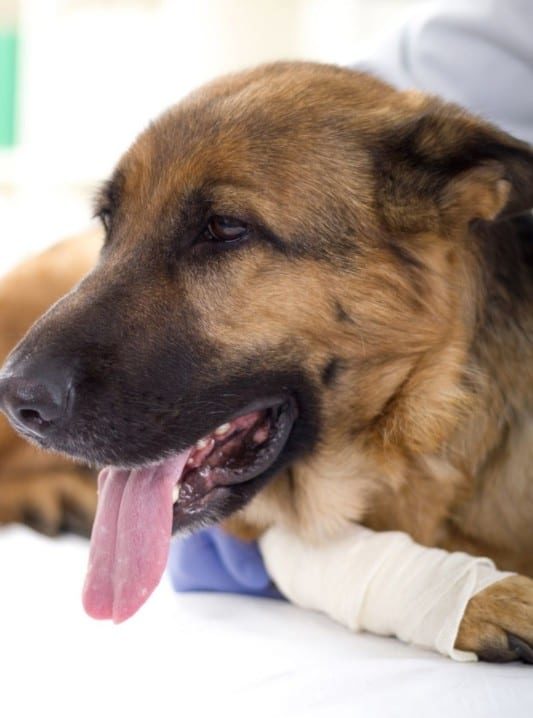
Veterinary Care
Armed with the knowledge of the many reasons why your GSD may be hobbling around, and you’ve provided first aid where appropriate, you may now wonder when you should take your German Shepherd to the vet for limping.
You should take your German Shepherd to the vet for a diagnosis related to limping if he is in extreme pain, has an obvious fracture, can’t get up or move, has excessive swelling in his leg, or is bleeding heavily.
If the limping isn’t an emergency, but the lameness has continued for 24 hours, take him to be checked out.
FAQs
Why is my dog limping but showing no sign of pain?
It isn’t uncommon for dogs to limp but show no signs of pain, and this is a case when your dog is exposed to an internal injury or a serious condition that slowly develops over time. Probably, the pain would’ve just begun and is tolerable. It can slowly aggravate and cause discomfort.
Why is my German Shepherd limping after lying down?
When your German Shepherd is limping after lying down, arthritis or other joint problems could be the reason. Such dogs make slow movements but feel extreme pain when they lie down to rest. This is common in aged dogs, where they develop osteoarthritis and begin to limp frequently after lying down.
Can a dog’s limp heal on its own?
A dog’s limp can heal on its own in two circumstances – the low intensity of the injury or if it’s a puppy with an excellent recovery period. Otherwise, limps are known to sustain and aggravate over time based on the dog’s breed, health condition, age, and nature of pain.
Can puppies limp too?
Puppies can limp, too, when they have a tiny scratch or a wound on their legs. In such cases, recovery is easier and faster due to the development of their immune systems. However, if it’s the onset of a joint disease, it could take longer, but this is only a rare case.
How can I assess if my German Shepherd’s limp is serious?
To assess the seriousness of your German Shepherd’s limp, it is important to examine the affected leg for any visible signs of injury, such as swelling, cuts, or deformities.
Additionally, monitoring your dog’s behavior and pain level can provide valuable insight into the cause of the limp, as some dogs may whimper or become reluctant to walk.
How common is it for German Shepherds to experience limping?
While it is not uncommon for German Shepherds to experience occasional limping, it is essential to investigate the cause to ensure their well-being and prevent any further discomfort.
Possible reasons for a German Shepherd limping could range from a minor injury, such as a sprained paw or muscle strain, to more serious conditions like hip dysplasia or arthritis.
How long does it take for a German Shepherd’s limp to heal?
The healing time for a German Shepherd’s limp can vary depending on the underlying cause and the severity of the injury. It is recommended to consult a veterinarian for a proper diagnosis and treatment plan to ensure the best possible recovery for your pet.
Final Thoughts
Unfortunately, our doggos can’t tell us what’s wrong if they are unwell or in pain. Don’t worry, though, as you’ll now be able to use your knowledge from this article to help you work out why your German Shepherd is limping.
Although limping in dogs is common for many reasons, it’s not normal. Nonetheless, some causes are pretty rare.
Nowadays, there are many options to help a limping dog. Anti-inflammatories and painkillers can massively help, as they seem to do with my dog. There are also other drugs to improve joint health that you can discuss with your vet.
Fractures can be treated with a splint or cast or repaired surgically, depending on the severity. Other treatments are joint supplements such as YuMOVE mentioned above, limiting movements, and physiotherapy. With the proper treatment, your German Shepherd will be back on all four paws in no time.





